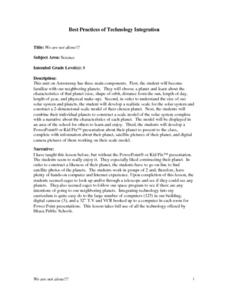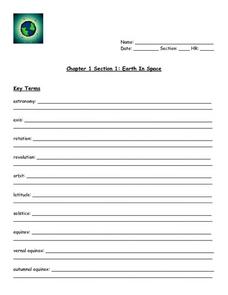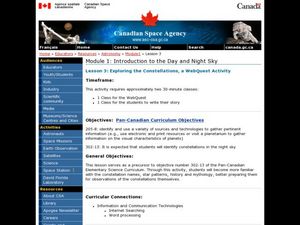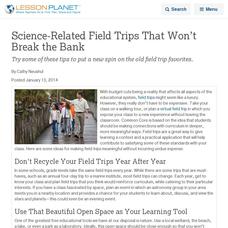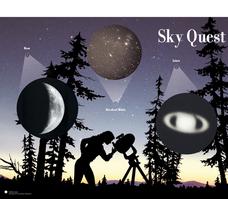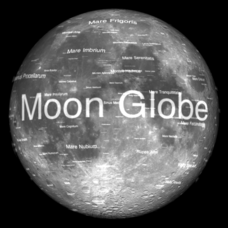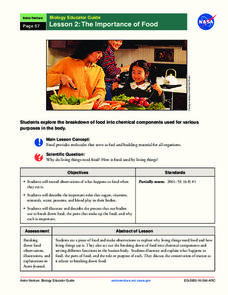Curated OER
Why is There a Tidal Bulge Opposite the Moon?
Students simulate how the Moon causes ocean tides. In this earth science lesson, students calculate gravitational acceleration using a mathematical formula. They compare the force of attraction between the Earth, Moon and Sun system.
Curated OER
Mensa For Kids: The Moon
First graders explore space science by completing an arts and crafts activity. In this moon lesson, 1st graders explore the geography of the moon and discuss the importance it has for people living on Earth. Students create a replica...
Curated OER
Astronomical Scales
High schoolers describe the different units of measurement. In this space science lesson, students calculate astronomical distances using a scale. They explain the significance of using scientific notation in expressing very small...
Curated OER
Make a Spaceship
Students create a spaceship, satellite, or space station. In this space lesson, students consider design elements for buildings and objects in space. Students use K'Nex, Legos, or other household materials for their creation. Students...
Curated OER
Swinging on a Star
Students explore the issues that might arise if humans were to go on an interstellar space mission. They synthesize their understanding of interstellar travel by writing scenes from a science fiction novel that would depict such a mission.
Curated OER
We Are Not Alone!!!
Eighth graders explore the area of astronomy. They explore Earth's neighboring planets. Students research a planet's characteristics. They develop a scale model of the solar system and a narrative about the planets.
Curated OER
Astronomical Song Lyrics
In this astronomy and song lyrics worksheet, students are given 10 lyric fragments from different artists. Students select 3 of the fragments and write short essays about each to explain their thoughts from a human and astronomical point...
Curated OER
Hot Air
Students conduct an experiment to determine how hot air affect the path of laser. In this physics lesson, students explain why stars appear to twinkle at night. They discuss how light travels from space to Earth.
Curated OER
Earth in Space
In this reason for the days and nights on earth worksheet, students study the reasons the Earth has days and nights by answering 28 questions about earth's rotation, the equator, the relationship between the sun and moon, and the earth's...
Curated OER
How Do Astronomers Measure Distances to Stars?
In this astronomy worksheet, students participate in an activity using the parallax effect to measure star distances. They record their information in a data table then complete 5 fill in the blank conclusion questions.
Curated OER
Lesson Plan on Kepler's Laws of Planetary Motion
Students construct a solar system model. In this space science lesson, students calculate the eccentricity of a planet's orbit. They calculate the period of a planet's revolution using Kepler's formula.
Curated OER
Edible Model of the Sun
Students identify the different features of the Sun. In this space science instructional activity, students create a model of its surface using cookies and candies. They compare and contrast their model to the real Sun.
Curated OER
Exploring the Constellations, a WebQuest Activity
Students explore space science by participating in a class WebQuest. In this constellation identification lesson, students view star charts based on the four seasons and identify the changes our sky goes through in the course of 12...
Curated OER
Get the Picture!
Astronomers practice downloading data from a high-energy satellite and translate the data into colored or shaded pixels. As a hands-on activity, they use pennies to simulate high-energy satellite data and they convert their penny...
Curated OER
Constellations
Students investigate the concept of the constellations using many different resources to find information. Then students use the information in order to construct models of the constellations that show the magnitude of their size and...
Curated OER
Science-Related Field Trips That Won’t Break the Bank
Try some of these tips to put a new spin on the old field trip favorites.
NASA
Tools of the Trade
Did you know every state in the U.S. has at least one observatory? During the lesson, scholars research the cost of building and maintaining an observatory. They must present their information in a proposal to build a new observatory,...
K12 Reader
A Planet in the Solar System
Take young scientists on an exploration of the cosmos with this cross-curricular writing exercise. Tasked with producing an expository composition describing a planet of their choosing, students perform research and...
Curated OER
Sky Quest: Exploring the Constellations
Students examine constellations and planets through completing various activities. Students work individually and in groups to create drawings based on stars, compare and contrast the night sky with and without a telescope and learn...
Curated OER
How Hot is that Star?: Astronomy, Sun, Solar Temperature, Science
Students explain sun facts and solar information. They discover how temperature of a star is measured. They investigate the various scales used to measure temperature. They observe images of the sun. They classify stars according to te
Midnight Martian
Moon Globe
Not just a simple globe of the moon, this interactive version allows you to choose lighting according to the location of the sun, views from different positions on Earth, and more! Satellite images and topographic data have been combined...
NASA
The Importance of Food
Pupils make observations while eating food. They act out the process of food breaking down in the body and the roles of various chemical components, such as sugar and protein. It concludes with an activity illustrating the process and a...
Curated OER
Hubble Space Telescope
Students investigate the universe through the eyes of the Hubble space telescope. They conduct research from looking at the universe that is simulated with a digital projector. The images are projected onto the wall in a simulation of...
University of Colorado
Astro-Chronology
Class members play a version of the game Chronology to determine when certain scientific events occurred in history. Teams play until someone has 5-10 events in the correct order.







